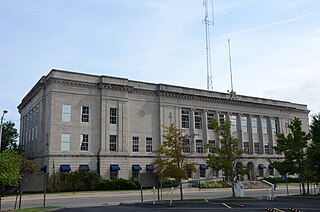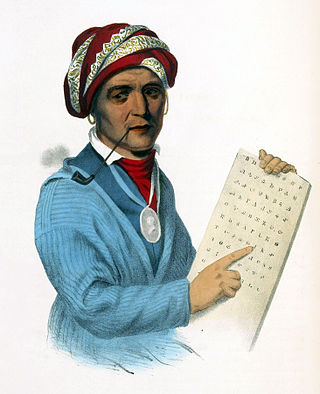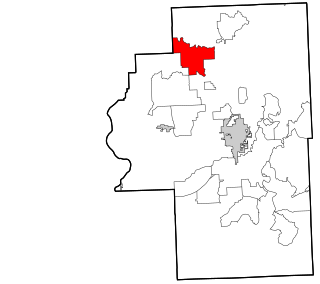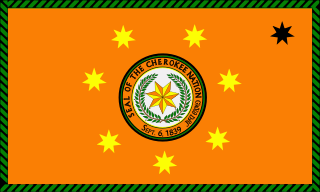
Muskogee County is a county located in the U.S. state of Oklahoma. As of the 2020 census, the population was 66,339. The county seat is Muskogee. The county and city were named for the Muscogee (Creek) Nation. The official spelling of the name was changed to Muskogee by the post office in 1900.

Cherokee County is a county located in the U.S. state of Oklahoma. As of the 2020 census, the population was 47,078. Its county seat is Tahlequah, which is also the capital of the Cherokee Nation.

Park Hill is an unincorporated community and census-designated place (CDP) in southwestern Cherokee County, Oklahoma, United States. The population was 3,909 at the 2010 census. It lies near Tahlequah, east of the junction of U.S. Route 62 and State Highway 82.

Tahlequah is a city in Cherokee County, Oklahoma located at the foothills of the Ozark Mountains. It is part of the Green Country region of Oklahoma and was established as a capital of the 19th-century Cherokee Nation in 1839, as part of the new settlement in Indian Territory after the Cherokee Native Americans were forced west from the American Southeast on the Trail of Tears.

Sequoyah, also known as George Gist or George Guess, was a Native American polymath and neographer of the Cherokee Nation. In 1821, he completed his independent creation of the Cherokee syllabary, making reading and writing in Cherokee possible. His achievement was one of the few times in recorded history that an individual who was a member of a pre-literate group created an original, effective writing system. His creation of the syllabary allowed the Cherokee nation to be one of the first North American Indigenous groups to have a written language. Sequoyah was also an important representative for the Cherokee nation, by going to Washington, D.C. to sign two relocations and trading of land treaties.

The Qualla Boundary or The Qualla is territory held as a land trust by the United States government for the federally recognized Eastern Band of Cherokee Indians, who reside in western North Carolina. The area is part of the large historic Cherokee territory in the Southeast, which extended into eastern Tennessee, western South Carolina, northern Georgia and Alabama. Currently, the largest contiguous portion of the Qualla lies in Haywood, Swain, and Jackson counties and is centered on the community of Cherokee, which serves as the tribal capital of the Eastern Band of Cherokee Indians. Smaller, discontiguous parcels also lie in Graham and Cherokee counties, near the communities of Snowbird and Murphy respectively.

The United Keetoowah Band of Cherokee Indians in Oklahoma is a federally recognized tribe of Cherokee Native Americans headquartered in Tahlequah, Oklahoma. According to the UKB website, its members are mostly descendants of "Old Settlers" or "Western Cherokee," those Cherokee who migrated from the Southeast to present-day Arkansas and Oklahoma around 1817. Some reports estimate that Old Settlers began migrating west by 1800. This was before the forced relocation of Cherokee by the United States in the late 1830s under the Indian Removal Act.

Peggs is an unincorporated community and census-designated place (CDP) in Cherokee County, Oklahoma, United States. It had a population of 813 at the 2010 census, compared to 814 at the 2000 census. A large minority of its residents are Native American, most of them members of 10 tribal groups such as the Cherokee Nation and the Muscogee Creek Nation.

The Cherokee Nation, also known as the Cherokee Nation of Oklahoma, is the largest of three Cherokee federally recognized tribes in the United States. It includes people descended from members of the Old Cherokee Nation who relocated, due to increasing pressure, from the Southeast to Indian Territory and Cherokee who were forced to relocate on the Trail of Tears. The tribe also includes descendants of Cherokee Freedmen, Absentee Shawnee, and Natchez Nation. As of 2023, over 450,000 people were enrolled in the Cherokee Nation.
Cecil Dick, or Degadoga (1915–1992) was a well-known Cherokee artist often referred to as "the Father of Cherokee Traditional Art".

The Bureau of Indian Education (BIE), headquartered in the Main Interior Building in Washington, D.C., and formerly known as the Office of Indian Education Programs (OIEP), is a division of the U.S. Department of the Interior under the Assistant Secretary for Indian Affairs. It is responsible for the line direction and management of all BIE education functions, including the formation of policies and procedures, the supervision of all program activities, and the approval of the expenditure of funds appropriated for BIE education functions.

Bill John Baker is a Native American politician who served as Principal Chief of the Cherokee Nation. First elected in October 2011, Baker defeated three-term incumbent Chief Chad "Corntassel" Smith. Prior to his election as Chief, Baker served 12 years on the Cherokee Tribal Council. In 1999, Baker unsuccessfully ran for Deputy Chief of the Cherokee Nation.

Cherokee language is the indigenous American Iroquoian language native to the Cherokee people. In 2019, the Tri-Council of Cherokee tribes declared a state of emergency for the language due to the threat of it going extinct, calling for the enhancement of revitalization programs.

The Cherokee Immersion School is a Cherokee language immersion school in Park Hill, Oklahoma, with a Tahlequah post office address. It is for children during pre-school to grade 8.
Mary Adair is a Cherokee Nation educator and painter based in Oklahoma.

Anna Mitchell was a Cherokee Nation potter who revived the historic art of Southeastern Woodlands pottery for Cherokee people in Oklahoma. Her tribe designated her as a Cherokee National Treasure and has works in numerous museum collections including the Smithsonian National Museum of the American Indian, the Museum of Fine Arts, Boston, and the Fred Jones Jr. Museum of Art, among others.

Durbin Feeling was a Cherokee Nation linguist who wrote the primary Cherokee–English dictionary in 1975. He is considered the greatest modern contributor to the preservation of the endangered Cherokee language.
Hunters Point Boarding School, Inc. is a boarding elementary school, operated by the Navajo tribe, in unincorporated Apache County, Arizona, with a St Michaels address. It is operated in partnership with the Bureau of Indian Education (BIE). A school board manages the school, which is funded with money from the federal government.
Flandreau Indian School (FIS), previously Flandreau Indian Vocational High School, is an boarding school for Native American children in unincorporated Moody County, South Dakota, adjacent to Flandreau. It is operated by the Bureau of Indian Education (BIE) and is off-reservation.

John Wesley "Wes" Nofire is a Cherokee Nation and American politician and a former heavyweight professional boxer. During his boxing career Nofire fought under the name "The Cherokee Warrior". Nofire has served on the Cherokee Nation tribal council since 2019 and was a Republican candidate in the 2022 primary election for Oklahoma's 2nd congressional district and candidate in the 2023 Cherokee Nation principal chief election.
















